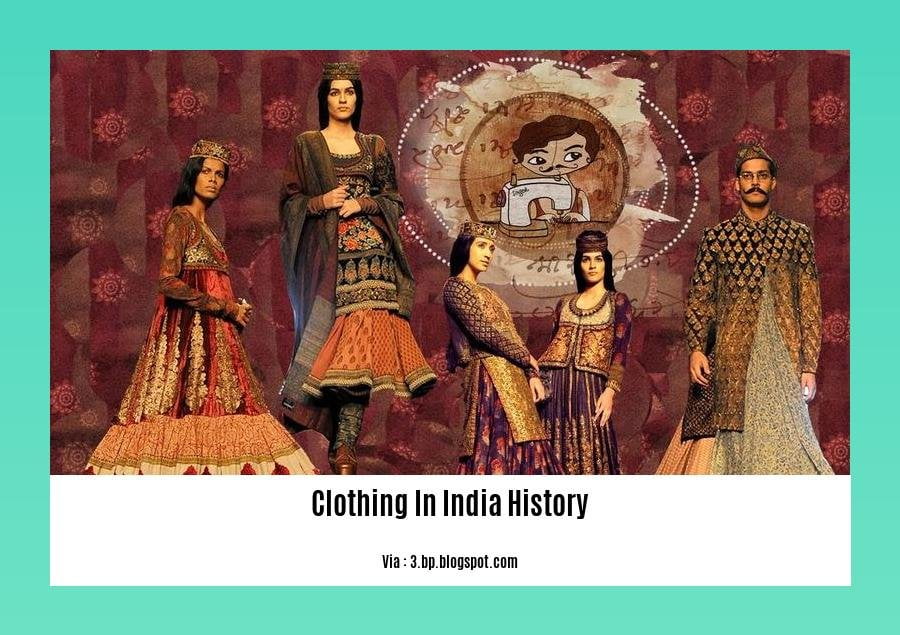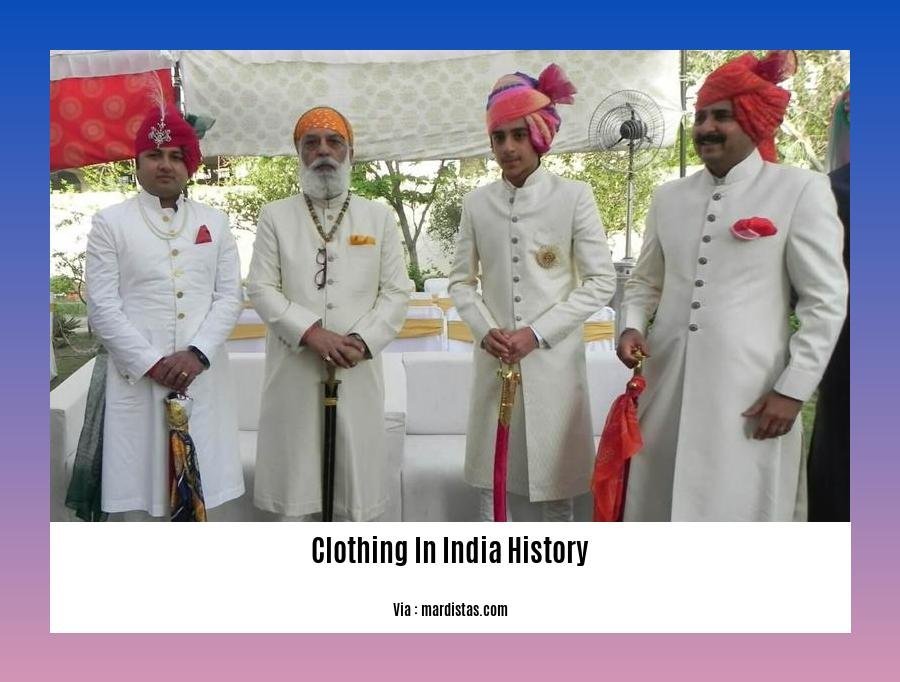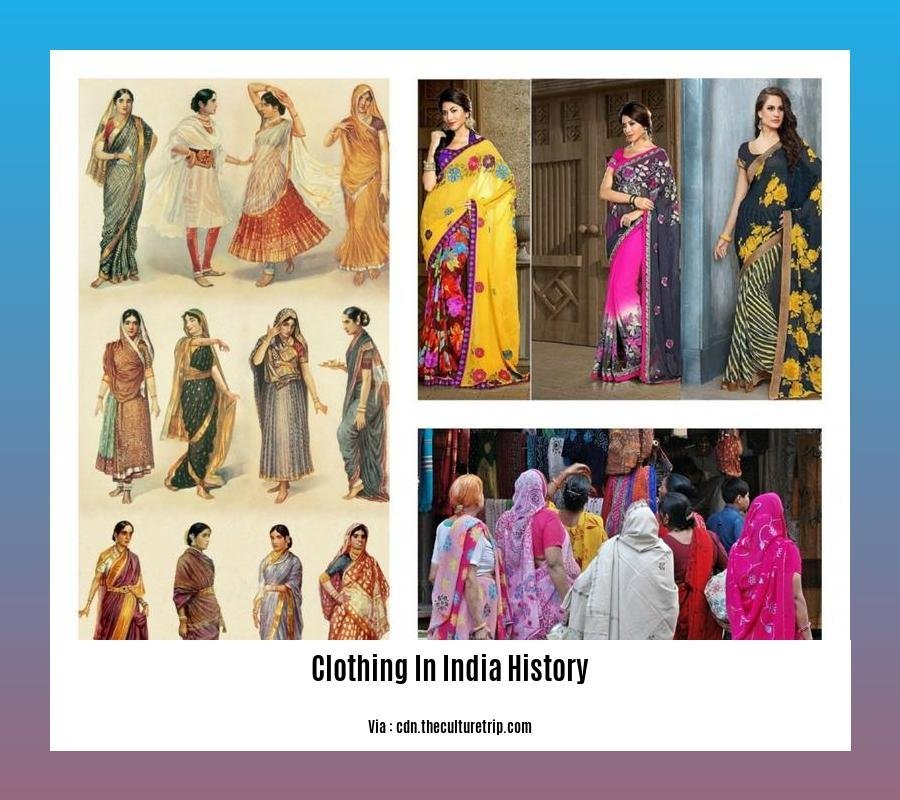Embark on a sartorial journey through time with “A Stitch in Time: Exploring the Evolution of Clothing in India Through the Millennia”! Delve into the rich tapestry of Indian attire, from ancient civilizations to contemporary trends, as we unravel the cultural, social, and economic factors that have shaped this nation’s unique fashion identity.
Key Takeaways:
-
India’s clothing has evolved based on geography, climate, and culture.
-
Textile impressions from the Indus Valley Civilization offer insights into ancient clothing.
-
Men and women wore unstitched garments during the Mauryan and Sunga period.
-
Weaving flourished during the Satavahana period, producing fine and coarse fabrics.
-
Regional variations reflect the vibrant cultural heritage of India.
Clothing in India Through the Millennia

Throughout the rich tapestry of Indian history, clothing has been a mirror reflecting the nation’s cultural evolution. Inspired by diverse influences, from geography and climate to societal norms, it’s a testament to India’s enduring ability to weave a vibrant sartorial narrative.
The Indus Valley Civilization: Laying the Threads
Journey back to the Indus Valley Civilization (2500-1900 BCE), where rudimentary textiles, imprinted on clay and preserved through pseudomorphs, hinted at the budding textile traditions that would bloom in the subcontinent.
Mauryan and Sunga Period: Draped in Elegance
Fast forward to the Mauryan and Sunga period (321-72 BCE), where men and women adorned themselves with three unstitched garments: the Antalya, muraja, and uttariya. These elegant drapes, crafted from natural fibers, laid the foundation for India’s rich textile heritage.
Satavahana Period: Weaving Masterpieces
In the Satavahana period (230 BCE – 220 CE), the art of weaving flourished, producing both fine and coarse varieties of cloth. From opulent silks to sturdy cottons, the textile industry showcased India’s growing prowess in this field.
Regional Diversity: A Kaleidoscope of Colors
India’s clothing traditions are as varied as its geography. The vibrant colors and intricate embroidery of the north contrast with the flowing drapes and muted tones of the south, each region showcasing its unique cultural identity.
Climate and Geography: Shaping Styles
Climate and geography have played a pivotal role in shaping India’s clothing styles. In the blistering heat of the Thar Desert, loose-fitting garments provide respite, while in the chilly climes of the Himalayas, layered clothing offers warmth.
A Tapestry of Influences: International Flavors
India’s clothing history is a testament to its openness to international influences. From the flowing tunics of Central Asia to the elegant gowns of Persia, various cultures have left their mark on the Indian wardrobe.
Modern India: A Fusion of Tradition and Trends
Contemporary clothing in India strikes a delicate balance between tradition and modernity. While traditional textiles and designs are cherished, there’s also an embrace of global fashion trends, resulting in a vibrant fusion that defines modern Indian style.
- To understand the significant events that shaped modern India’s history, delve into the comprehensive chronology of modern Indian history.
- The contemporary dance history traces the evolution of a form that blends tradition with the modern spirit.
- Discover the early church history timeline to witness the growth of the Christian faith from its humble beginnings.
Cultural Influences: Analyzing the impact of trade and cultural exchanges with regions like Persia, China, and Central Asia on the evolution of Indian clothing styles and motifs.
Cultural exchanges have served as vibrant threads in the tapestry of Indian attire, weaving together influences from Persia, China, and Central Asia. These interactions, facilitated by trade routes like the Silk Road, sparked a cross-pollination of ideas, techniques, and motifs that left an indelible mark on Indian fashion.
Persia: The Allure of Embroidery and Tunics
From the land of Persia, Indian artisans absorbed the art of intricate embroidery, embellishing garments with shimmering threads and vibrant hues. The tunic, a loose-fitting garment common in Persia, also made its way into the Indian wardrobe, offering a comfortable and stylish option for both men and women.
China: The Silk Route’s Exquisite Weaves
Along the Silk Road, Indian merchants encountered the exquisite silks of China, renowned for their luxurious texture and vibrant colors. These fabrics were eagerly incorporated into Indian attire, adding a touch of opulence and sophistication. In return, India introduced to China its mastery of cotton cultivation and weaving, contributing to a rich exchange of textile knowledge.
Central Asia: Embracing the Turban and Trousers
From the steppes of Central Asia, Indian fashion adopted the turban, a versatile head covering that offered both protection from the elements and a touch of ethnic flair. Additionally, the trousers, a comfortable and practical garment from this region, were embraced by Indian men, becoming an essential part of their attire.
A Tapestry of Cultural Exchange
The cultural influences from Persia, China, and Central Asia left an indelible mark on Indian clothing. These exchanges not only introduced new fabrics, garments, and techniques but also enriched the cultural significance of clothing in India.
Key Takeaways:
- The Silk Road facilitated a vibrant exchange of textile ideas, techniques, and motifs between India and regions like Persia, China, and Central Asia.
- Persian influence brought intricate embroidery and the tunic to Indian fashion.
- From China, India adopted the luxurious fabrics of silk, while introducing its expertise in cotton cultivation and weaving.
- Central Asian influences included the adoption of the turban and trousers in Indian attire.
- These cultural exchanges not only enriched the diversity of Indian clothing but also contributed to its cultural significance.
References:
-
The Silk Road: A History
-
The History of Indian Textiles
Regional Diversity: Exploring the distinct regional variations in clothing traditions across India, from the vibrant colors of Rajasthan to the elegant sarees of South India.

In the vibrant tapestry of Indian clothing, regional diversity plays a captivating role, showcasing a rich array of styles, colors, and fabrics that reflect the country’s cultural and geographic diversity.
Across the vast panorama of India, each region boasts its own distinct clothing traditions, influenced by climate, geography, culture, and history. From the vibrant colors and intricate embroidery of Rajasthan to the elegant sarees and flowing drapes of South India, the diversity of Indian attire is a testament to the country’s rich cultural heritage.
Northern India: A Symphony of Colors
The northern region of India is renowned for its vibrant colors and intricate embroideries, a reflection of the region’s rich cultural heritage and vibrant festivals.
Rajasthan: A Kaleidoscope of Hues
Rajasthan, with its shimmering deserts and vibrant culture, is a land where clothing speaks volumes. Women adorn themselves in colorful ghagra-cholis, skirts adorned with mirrors and intricate embroidery, while men sport turbans and colorful waistcoats.
Punjab: A Celebration of Simplicity
In Punjab, the land of five rivers, clothing is characterized by its simplicity and elegance. Women often wear salwar kameez, a traditional suit comprising loose trousers and a long tunic, while men favor kurta pajamas, a combination of a long tunic and loose pants.
Southern India: Graceful Drapes and Subtle Elegance
The southern region of India is known for its elegant sarees and flowing drapes, reflecting the region’s refined culture and tropical climate.
Tamil Nadu: The Land of Kanjivaram Sarees
Tamil Nadu, with its rich textile heritage, is renowned for its exquisite Kanjivaram sarees. These sarees, woven from pure silk, are adorned with intricate designs and vibrant colors, making them a symbol of elegance and grace.
Kerala: A Symphony of Simplicity
In Kerala, the land of backwaters and coconut palms, clothing is characterized by its simplicity and comfort. Women wear mundum neriyathum, a traditional two-piece garment consisting of a white cotton sari and a colorful blouse, while men favor mundu, a long white cotton dhoti.
Eastern India: A Blend of Traditions
The eastern region of India is a melting pot of cultures, with clothing traditions that reflect the region’s diverse ethnic groups.
West Bengal: The Land of the Sari
West Bengal, the land of Rabindranath Tagore, is synonymous with the saree. Women drape themselves in sarees of various styles and fabrics, showcasing the region’s rich textile heritage.
Odisha: A Symphony of Colors
In Odisha, the land of temples and festivals, clothing is vibrant and colorful. Women wear sarees in bold colors and intricate designs, while men favor dhotis and kurtas.
Western India: A Fusion of Styles
The western region of India is a vibrant blend of cultures, with clothing traditions that reflect the region’s historical trade connections.
Gujarat: A Tapestry of Textiles
Gujarat, with its rich textile industry, is known for its vibrant patola sarees, characterized by their intricate geometric designs and vibrant colors.
Maharashtra: A Symphony of Styles
In Maharashtra, the land of Marathi culture, clothing is a blend of traditional and modern styles. Women often wear sarees or salwar kameez, while men favor dhotis or kurta pajamas.
Conclusion
The regional diversity of Indian clothing is a testament to the country’s rich cultural heritage and diverse geography. Each region boasts its own unique styles, colors, and fabrics, reflecting the region’s unique identity and traditions. As India continues to evolve, its clothing traditions will undoubtedly continue to adapt and change, while retaining their essence and charm.
Key Takeaways:
- India’s regional clothing diversity reflects the country’s cultural and geographic diversity.
- Northern India is known for its vibrant colors and intricate embroidery, while southern India is renowned for its elegant sarees and flowing drapes.
- Eastern India showcases a blend of traditions, with West Bengal being synonymous with the saree and Odisha known for its colorful attire.
- Western India, influenced by trade connections, exhibits a fusion of styles, including Gujarat’s patola sarees and Maharashtra’s blend of traditional and modern clothing.
- Regional clothing traditions are a testament to India’s rich cultural heritage and continue to evolve while retaining their essence and charm.
Sources:
- The Regional Diversity of Indian Clothing. Fashion Lady.
- A Journey Through India’s Regional Clothing Traditions. The Indian Fashion Blog.
Contemporary Trends: Discussing the influence of globalization, Bollywood, and urban lifestyles on the changing landscape of Indian fashion, including the rise of fusion styles and the revival of traditional crafts.
In the realm of fashion, globalization, Bollywood, and urban lifestyles have emerged as powerful catalysts of change, reshaping the landscape of Indian fashion in remarkable ways. Let’s delve into this fascinating journey of evolution:
Globalization:
- The world has become a smaller place, with cultural borders blurring and international influences freely flowing across continents. This has had a profound impact on Indian fashion, as trends from distant lands now grace Indian streets.
- Global fashion brands have set up shop in India, introducing new styles and designs that have captivated Indian consumers.
- Indian designers have embraced this global exchange, infusing their creations with international influences while retaining their cultural essence.
Bollywood:
- Bollywood, the vibrant film industry of India, has played a pivotal role in shaping fashion trends across the country.
- Bollywood movies showcase stunning costumes, often featuring traditional Indian attire with a contemporary twist.
- These cinematic creations have inspired fashion enthusiasts to experiment with fusion styles, blending traditional elements with modern silhouettes.
- Bollywood celebrities, with their immense fan following, have become style icons, influencing the masses’ fashion choices.
Urban Lifestyles:
- The rise of urban lifestyles in India has brought about significant changes in fashion preferences.
- In cities, people lead fast-paced lives, demanding comfortable and versatile clothing that can keep up with their dynamic routines.
- This has led to the popularity of fusion wear, which seamlessly merges traditional Indian elements with Western influences, creating garments that are both stylish and functional.
- Urban fashion has also witnessed a revival of traditional crafts, as designers seek to preserve India’s rich textile heritage while catering to modern tastes.
Fusion Styles:
- Fusion styles have emerged as a dominant trend in contemporary Indian fashion, blurring the lines between traditional and modern.
- Designers are experimenting with unique combinations of fabrics, colors, and silhouettes, creating garments that are both visually appealing and culturally relevant.
- This trend has been particularly popular among younger generations, who embrace the opportunity to express their individuality through fashion.
Revival of Traditional Crafts:
- Alongside the rise of fusion styles, there has been a growing appreciation for traditional Indian crafts and textiles.
- Designers are incorporating traditional weaving, embroidery, and printing techniques into their collections, giving a nod to India’s rich cultural heritage.
- This revival has not only sustained traditional crafts but has also created new opportunities for artisans and weavers, preserving their livelihoods.
Key Takeaways:
- Globalization has brought international fashion trends to India, influencing local designs.
- Bollywood movies have popularized fusion styles, inspiring fashion enthusiasts to experiment with traditional and modern elements.
- Urban lifestyles have fueled the demand for comfortable and versatile fusion wear.
- Fusion styles have become a dominant trend, allowing designers to express their creativity and cater to modern tastes.
- Traditional crafts have experienced a revival, as designers incorporate them into contemporary designs, preserving India’s cultural heritage.
Sources:
- The Globalization of Indian Fashion
- Bollywood’s Influence on Indian Fashion
FAQ
Q1: What clothing did people wear in ancient India?
A1: In ancient India, during the Indus Valley Civilization (2500-1900 BCE), evidence suggests the use of textiles made from cotton and wool. Men wore loincloths and shawls, while women wore long skirts with blouses.
Q2: How did clothing change during the Mauryan and Sunga period?
A2: In the Mauryan and Sunga period (321-72 BCE), people began wearing three unstitched garments: the Antariya (lower garment), Muraja (sash), and Uttariya (upper garment). These garments were made from cotton, linen, and silk.
Q3: What were the characteristics of clothing in the Satavahana period?
A3: During the Satavahana period (230 BCE-220 CE), the weaving of both fine and coarse varieties of cloth was well-established. Cotton remained the primary fiber used, and garments were often adorned with embroidery, appliques, and other embellishments.
Q4: How does geography influence clothing in India?
A4: India’s diverse geography, with its varying climates and landscapes, has significantly influenced clothing styles. For example, in hot and humid regions, people tend to wear loose-fitting, lightweight garments made from natural fibers like cotton, while in colder regions, they wear warmer clothes made from wool or other insulating materials.
Q5: What materials were commonly used in traditional Indian clothing?
A5: Traditional Indian clothing was primarily made from natural fibers such as cotton, linen, silk, and wool. Cotton was the most commonly used fiber due to its breathability and comfort, especially in warm climates. Wool was used for winter clothing due to its insulating properties, while silk was reserved for special occasions due to its luxurious appearance and texture.
- Unveiling the Enigma: Mansoureh Khojasteh Bagherzadeh’s Public Appearances & Private Life in Iran - July 18, 2025
- Unveiling the Mystery: Mansoureh Khojasteh Bagherzadeh’s Husband: A Rare Glimpse into a Private Life - July 18, 2025
- Unveiling Masoud Khamenei’s Mother: Power, Influence, and Iran’s Future - July 18, 2025
















